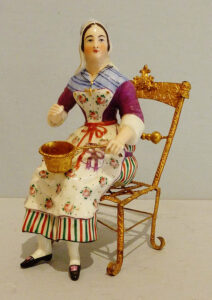 SB sent me photos of a 19th century Quimper ceramic figure. It’s a relief-painted scullery maid, holding a gold-gilded metal cookpot, seated on a gold-gilded metal chair. Such an interesting combination of materials here. A glazed and painted pottery figure sits on a gilded metal chair. To produce such a piece in the 19th century took a number of skilled artisans, and the collaboration of two workshops. They needed a ceramic production shop with a kiln, as well as a metalwork shop with the capacity to cast molten metal from a mold.
SB sent me photos of a 19th century Quimper ceramic figure. It’s a relief-painted scullery maid, holding a gold-gilded metal cookpot, seated on a gold-gilded metal chair. Such an interesting combination of materials here. A glazed and painted pottery figure sits on a gilded metal chair. To produce such a piece in the 19th century took a number of skilled artisans, and the collaboration of two workshops. They needed a ceramic production shop with a kiln, as well as a metalwork shop with the capacity to cast molten metal from a mold.
The cost to produce this figure came high for such novelty with no use except as fanciful decoration. The figure stands five and half inches tall and two and a half inches wide. The composition is in three pieces: French faience figure of the maid, a gold gilded chair, and pot. The workmanship is exquisite because the faience figurine “sits” on the chair and “holds” a pot. SB said she lost information about this figure she purchased from a dealer fifteen years ago.
Quimper in Breton
The clothing and furniture design give a clue to its origin location or place of production. The figure wears a traditional Breton (France) costume, with the “bigoudene’ headdress. Each region of Breton, whose ethnic origin is Celtic, has a slightly different white lace cap for women. The figure wears a traditional corselette, a shawl and apron. This traditional Breton costume originated only after the French government repealed the Sumptuary Laws in the early 19th century that governed a universal style of clothing. Add to this that the fabric produced throughout the 19th century became less expensive due to Industrial Revolution’s mass production. Each rural region of Breton outdid the next.
The national Breton Costume emerged, coincidentally, with the discovery of a type of clay in the region around Quimper in Breton. Potters re-invented a method of firing and painting the clay, a style known for a millennia, called faience. Breton potters specialized in this type of homely figure and this type of glazing. The figure is NOT porcelain, fired at a much higher temperature than stoneware. Faience is stoneware. The name faience refers to a white glaze that LOOKS like porcelain. Potters painted the white glaze then painted the glaze with enameled colors to emulate hand painted porcelain on pure white porcelain. The end product aimed at a facsimile of a porcelain figure, but required far less money to purchase. Porcelain came dear in the 18th and early 19th centuries. Faience not so much, relatively speaking.
Tin-glazed Pottery
To achieve that shiny white glaze they added an alloy: tin. This called this type of pottery, first invented as early as the 9th century in the Middle East, tin-glazed ceramic (faience). You might have heard the term Maiolica or Majolica: that is the faience or tin glazed pottery of Spain and Portugal, and sometimes used to describe French faience. In the Netherlands, they called it Delft.
France produced the most interesting faience in my opinion. The smaller kilns produced such interesting regional country-style wares, such as this Quimper figure. Quimper is famous for its homely peasant girl image on faience dishware widely collected in the early 20th century. The modeling of the metal chair indicates a pared-down version of the Louis 16th style of country furniture in France called French Provincial, popular with American collectors in the early 20th century.
Collaboration
The modeling on the figure’s face suggest a skilled artisan, and the inclusion of a metal chair and a metal pot in the figurine indicates a collaboration between a metal artisan and a ceramic artisan. Some serious engineering, illustrated by the hole on the underside of the figure. This became typical of the mid to the late 19th century in which the desire for specialize. Unique pieces required the creative collaboration of both metal and ceramic artists.
A similar collaboration occurred in England and Hollard in the 18th century when the first imported Chinese porcelain. Europeans didn’t know the chemical combinations needed to create porcelain. European silversmiths created fancy metal armatures around vessel of rare Chinese porcelain. Likewise, in England in the mid to late 19th century, the collaborative workmanship of both silver and glass artisans created centerpieces of glass or fine porcelain set into silver or dore bronze. They sold to those who afforded the novelty. The Quimper figure is worth $500.